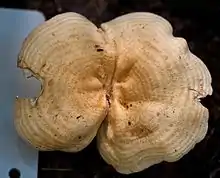| Multifurca | |
|---|---|
 | |
| Unidentified Multifurca species from New South Wales, Australia | |
| Scientific classification | |
| Domain: | Eukaryota |
| Kingdom: | Fungi |
| Division: | Basidiomycota |
| Class: | Agaricomycetes |
| Order: | Russulales |
| Family: | Russulaceae |
| Genus: | Multifurca Buyck & V. Hofst. (2008) |
| Type species | |
| Multifurca ochricompacta (Bills & O.K.Mill.) Buyck & V. Hofst. (2008) | |
| Species | |
|
M. aurantiophylla | |
Multifurca is a rare genus of ectomycorrhizal fungi in the family Russulaceae. It was described in 2008, after molecular phylogenetic study had shown that it forms a monophyletic lineage within the family, sister to Lactarius.[1] The genus contains six species known from the United States, Mexico, Costa Rica, India, China, Thailand, Australia, and New Caledonia, but so far has not been reported from Europe, Africa, or South America.[1][2][3][4] Four of those species were formerly classified as Russula section Ochricompactae, and Multifurca furcata was originally described as a Lactarius species.[1]
Multifurca is morphologically intermediate between Lactarius and Russula: Fruitbodies have adnate to subdecurrent gills and are zonate; latex (as in Lactarius and Lactifluus) is present only in M. furcata; spore print is orange; spores themselves are very small with only faint ornamentation.[1]
The widespread but only punctual records of Multifurca suggest an ancient, relictual distribution.[1]
References
- 1 2 3 4 5 Buyck B, Hofstetter V, Eberhardt U, Verbeken A, Kauff F (2008). "Walking the thin line between Russula and Lactarius: the dilemma of Russula sect. Ochricompactae" (PDF). Fungal Diversity. 28: 15–40.
- ↑ Lebel T, Dunk CW, May TW (2013). "Rediscovery of Multifurca stenophylla (Berk.) T.Lebel, C.W.Dunk & T.W.May comb. nov. (Russulaceae) from Australia". Mycological Progress. 12 (3): 497–504. doi:10.1007/s11557-012-0856-4.
- ↑ Montoya L, Bandala VM, Halling R (2003). "Lactarius furcatus in Mexico and Costa Rica". Mycotaxon. 87: 311–316.
- ↑ Wang XH, Liu PG (2010). "Multifurca (Russulales), a genus new to China" (PDF). Cryptogamie, Mycologie. 31 (1): 9–16.
External links